
The Beginning of Life/Art: Cloth Weaves Our Times, from Aomori
May 7 (Thu)- August 30 (Sun), 2020
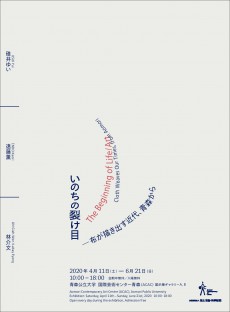
We are always wrapped in cloth from the time when we give our first cry until the time we die. Cloth protects us physically and mentally and it also represents who we are. In various locations on the globe, different kinds of cloth have been made and used, according to the climates and cultures of the places. In order to make cloth, we tear up animals and plants to use their skins or take out their fibers to spin, weave, and knit. We also cut cloth and sew it up to wear it. Destruction and regeneration happen repeatedly around cloth. The French thinker Georges Bataille once talked about how we humans attained humanity by making wall paintings in the caves; the Earth’s ‘fissures’, in the prehistoric age and how art originated through play by denying the value of labor(*1).
In Aomori, the northern tip of the Honshu island, we have rich and unique cultures, which originated because of the severe winters here. Including Sakiori, Sashiko and Kogin-zashi, and BORO as far as cloth making goes. They reflect people’s lives in rural villages. Making them must have provided people with the joy of doing handwork and being creative with colors and patterns within limits they had as well as challenges against the normative consciousness such as morals connected to gender. I do not mean to lightly refer to those objects as art by no means, but it is true that they teach us the joy of making them and wearing them and tell us many stories.
In this exhibition, derived from “Aomori City Archives Exhibition", the series of exhibitions ACAC had been doing, we will invite three artists based in Asia, who have been doing contemporary art projects, using handcraft, craft, and techniques rooted in traditional cultures. They will exhibit new works inspired by craft objects used among ordinary people, archived in the collection of the Aomori-city Board of Education(*2) and installations using important cultural properties. Guessing from the ideas the artists have shared with me, their works will theme around topics such as female education before the wars, war and firework, connections between the native people of Taiwan and Japan and they will give us opportunities to think about the times our predecessors lived in, which is continuous to our own times.
Gaps are created in layers by the objects themselves, and the expressions born in the process of making those objects. I hope that this exhibition will provide opportunities for us to look into these gaps, go beyond pre-conditioned communities such as nations, races, and families, and connect with others, both who are alive now and who were alive in the past. Because we humans cannot live alone after all.
-
*1 Bataille, Georges (1955), Prehistoric Painting: Lascaux or the Birth of Art
*2 The collection of Aomori City History and Ethnography Museum, Keiko-kan, has been transferred to Aomori City and the Cultural Porpoerties Devision of the Aomori City Board of Education. The museum was initially opened as Keiko-kan Foundation in 1977, was transferred to the Aomori City, and became a historical ethnological museum. Among others, Chuzaburo Tanaka acted as the museum director there. It was closed in 2006.

USUI Yui
Artist. Born in Tokyo in 1980 and lives in Saitama.
Dealing with events that happen or happened in the contemporary society and history from which people look away, Usui views her personal experiences and questions as social and political, and studies them through reference books and interviews for research so as to create a variety of works from the two-dimensional to installations using familiar techniques and materials such as handcrafts. Her major solo exhibitions include “shadow work” (Oyama City Kurumaya Museum of Art, 2016). In recent years, she has participated in many group exhibitions including Aichi Triennale 2019 (Nagoya City Art Museum, etc.) and Assembridge NAGOYA 2019 (the Nagoya Port area). At VOCA Exhibition 2018, she won the grand prize, VOCA Award.
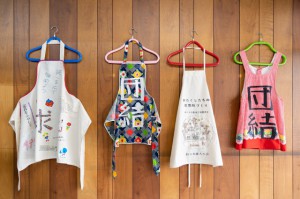 USUI Yui, demands and resistance(要求と抵抗), 2019
USUI Yui, demands and resistance(要求と抵抗), 2019
Photo: Ryohei Tomita, Photo courtesy: Assembridge NAGOYA Executive Committee
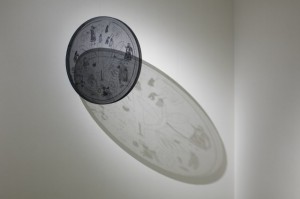 USUI Yui, shadow of a coin, 2013-2018 Photo: Shinya Kigure
USUI Yui, shadow of a coin, 2013-2018 Photo: Shinya Kigure
ENDO Kaori
Textile/Visual artist. Born in Osaka in 1989 and lives in Hanoi, Vietnam and Osaka.
Graduated from Textiles Course, Okinawa Prefectural University of Arts, and Ars Shimura. Endo intends to explore the essence of crafts rooted in everyday life from the perspective of contemporary art. As she believes that complex social facts are woven into textiles, she collects fabrics and repeatedly uses and repairs them. In recent years, she continues to visit different places in East Asia, mainly Okinawa and Vietnam, to conduct research on and collect respective local textiles. Her major solo exhibitions include “Gravity and Rainbow,” the 13th shiseido art egg, Endo Kaori Exhibition (Shiseido Gallery, 2019) in which she won the grand prize, the 13th shiseido art egg award. She has participated in group exhibitions including “BARRAK: survibes,” in Bangkok Biennial 2018 (White Line, Thailand, 2018).
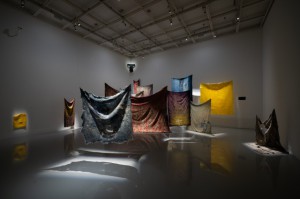 ENDO Kaori, Gravity and Rainbow(重力と虹霓), 2019 Photo: KATO Ken
ENDO Kaori, Gravity and Rainbow(重力と虹霓), 2019 Photo: KATO Ken
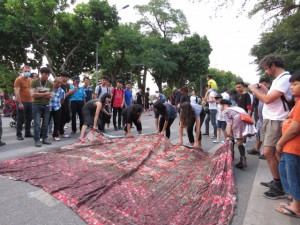 ENDO Kaori, Uesu (waste), 2018
ENDO Kaori, Uesu (waste), 2018
LIN Gieh-Wen/Labay Eyong
Artist. Born in Hualien, Taiwan in 1982 and lives there.
Completed master’s course of Temporary Space Design at Autonomous University of Barcelona. As a member of Truku tribe, indigenous people of Taiwan, she uses traditional weaving techniques while making use of her knowledge of jewelry design to create sculptural installations. Collaborating with weavers in the local community at times, she focuses on the female body and identities. While having participated in many exhibitions including international shows in Taiwan, she opens her exhibition for the first time in Japan. Her major exhibitions include “Taiwan Biennial: The Possibility of an Island” (National Taiwan Museum of Fine Arts, 2016) and “Hiding in the Island” (Museum of Contemporary Art Taipei, 2017).
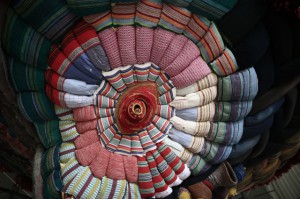 LIN Gieh-Wen(Labay Eyong), weaving roads(織路), 2015-2016
LIN Gieh-Wen(Labay Eyong), weaving roads(織路), 2015-2016
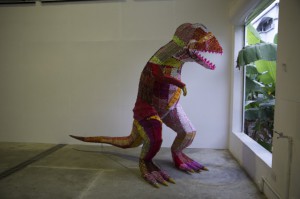 LIN Gieh-Wen(Labay Eyong), Red Dinosaur, 2019
LIN Gieh-Wen(Labay Eyong), Red Dinosaur, 2019
Organized by|Aomori Contemporary Art Centre (ACAC), Aomori Public University
In Cooperation with|Aomori City Board of Education, AIRS (Artist in Residence Supporters) , Art Club of Aomori Public University
Supported by|The Kao Foundation for Arts and Science
Endorsed by|Taiwan Cultural Center; Taipei Economic and Cultural Representative Office in Japan, NHK Aomori Broadcasting Station, Aomori Television Broadcasting Co., Ltd., Aomori Broadcasting Corporation, Asahi Broadcasting Aomori Co., Ltd., Aomori Cable Television, Aomori Fm Broadcasting, The To-o Nippo Press Co., MUTUSINPOU co,. ltd., The Dairy-Tohoku Shimbun Inc.
いのちの裂け目ー布が描き出す近代、青森から
2020年5月7日(木)ー8月30日(日)
air2020-1ja
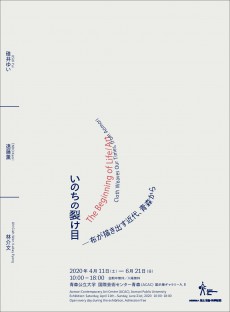
The Beginning of Life/Art: Cloth Weaves Our Times, from Aomori
人は産声を上げるときから死ぬまで、布につつまれています。それは物理的にも精神的にも私たちを守るものであり、何者かを示すものでもあります。世界各地でその土地の風土に合わせ、様々な布が作られ使われてきました。布を作るためには動植物を引き裂いて皮を用いたり、繊維を取り出し紡いだり、織ったり、編んだり。まとうためには布を裁って縫い合わせたりと、破壊と再生が繰り返されています。かつてフランスの思想家ジョルジュ・バタイユは、大地の「裂け目」である洞窟のなかで、先史時代に壁画を描くことで人間性が獲得されたこと、労働の有用性を否定することで遊びとしての芸術が誕生したことを語りました(*1)。
本州の最北端であるここ青森には、厳しい冬があるからこそ生まれた、独自の豊かな文化が存在します。布に関わるものでは、裂織や刺し子、ボロなど。それらは農村の暮らしを反映したものであり、制約のなかで色や柄を工夫する手仕事の楽しみでもあり、時にジェンダーなど規範意識との戦いでもあったでしょう。決してこれらについて、簡単にアートだと言いたいわけではありませんが、作ること身につけることの歓びや、ものが多くを語りかけてくることは事実です。
当館で行ってきた「青森市所蔵作品展」の流れを汲む本展では、アジアを拠点として手芸や工芸、伝統文化の技術をもとに現代美術の活動をするアーティスト3名が、青森市教育委員会が所蔵する民俗資料(*2)から発想した新しい作品、文化財を用いたインスタレーションを展観します。どうやら戦前の女子教育や戦争と花火、台湾原住民族と日本の関わりなど、現在と地続きである人々が生きてきた時代について考えることになりそうです。
ものそれ自体から、そしてそれから生まれた表現からも多層的に開いていく裂け目。この傷口を覗き込むことで、国家や民族、家族といった共同体を超えて、それでもひとりでは生きてゆけない私たちが、時をこえてつながる交感の場になればと思っています。
*1 ジョルジュ・バタイユ『ラスコーあるいは芸術の誕生』1955年
*2 青森市歴史民俗展示館 稽古館が収蔵していたものが、現在は市および市教育委員会文化財課に移管されている。展示館は1977年に財団法人稽古館として開館、1998年青森市に移管された歴史民俗系の博物館。田中忠三郎も館長を務めた。2006年に閉館。

碓井ゆい USUI Yui
1980年東京都生まれ、埼玉県在住。アーティスト。
現代社会において見てみぬ振りをされている出来事や歴史について、個人的な経験や疑問を社会的・政治的なものとして捉え、文献資料やインタビューによるリサーチを通して紐解き、手芸などの身近なテクニックや素材を用いて、平面からインスタレーションまで様々な作品を制作している。主な個展に「shadow work」(小山市車屋美術館、2016年)など。近年「あいちトリエンナーレ2019」(名古屋市美術館等)、「アッセンブリッジ・ナゴヤ2019」(名古屋港一帯)など多数のグループ展に参加している。「VOCA展2018」では大賞にあたるVOCA賞を受賞。
 USUI Yui, demands and resistance(要求と抵抗), 2019
USUI Yui, demands and resistance(要求と抵抗), 2019
Photo: Ryohei Tomita, Photo courtesy: Assembridge NAGOYA Executive Committee
 USUI Yui, shadow of a coin, 2013-2018 Photo: Shinya Kigure
USUI Yui, shadow of a coin, 2013-2018 Photo: Shinya Kigure
遠藤薫 ENDO Kaori
1989年大阪府生まれ、ベトナム・ハノイ/大阪府在住。工芸/美術作家。
沖縄県立芸術大学工芸専攻染織コースおよび、アルスシムラ卒業。生活に根差した工芸の本質を現代美術的な視座から探るべく、テキスタイルに複雑な社会的事実が織り込まれていると考え、布を集め使用と修復の行為を繰り返す。また近年では、沖縄やベトナムを中心とする東アジア各地を訪れ、それぞれの土地の布について調査と蒐集を続けている。主な個展に『重力と虹霓(こうげい)』「第13回shiseido art egg・遠藤薫展」(資生堂ギャラリー、2019年。本展において大賞にあたる第13回shiseido art egg賞を受賞)など。主なグループ展に「Bangkok Biennal 2018『BARRAK : survibes』」(White Line、タイ、2018年)など。
 ENDO Kaori, Gravity and Rainbow(重力と虹霓), 2019 Photo: KATO Ken
ENDO Kaori, Gravity and Rainbow(重力と虹霓), 2019 Photo: KATO Ken
 ENDO Kaori, Uesu (waste), 2018
ENDO Kaori, Uesu (waste), 2018
林介文(リン・ジェーウェン/ラバイ・イヨン) LIN Gieh-Wen / Labay Eyong
1982年台湾・花蓮出身、同地在住。アーティスト。
バルセロナ自治大学大学院(展示空間デザイン)修士課程修了。台湾原住民の太魯閣(トゥルク)族の一員として、伝統的な織物の技法を用いながら、ジュエリーデザインの知識も活かし、彫刻的なインスタレーション作品を制作している。時にコミュニティの織り手たちとも協働しながら、特に女性の身体性やアイデンティティーなどに焦点を当てている。台湾では国際展など多くの展覧会に参加しているが、日本での作品発表は初となる。主な展覧会に「2016 Taiwan Biennial: The Possibility of an Island」(国立台湾美術館)、「Hiding in the island」(台北当代芸術館、2017年)など。
 LIN Gieh-Wen(Labay Eyong), weaving roads(織路), 2015-2016
LIN Gieh-Wen(Labay Eyong), weaving roads(織路), 2015-2016
 LIN Gieh-Wen(Labay Eyong), Red Dinosaur, 2019
LIN Gieh-Wen(Labay Eyong), Red Dinosaur, 2019
主催|青森公立大学 国際芸術センター青森
協力|青森市教育委員会、AIRS(アーティスト・イン・レジデンス・サポーターズ)、青森公立大学芸術サークル ほか
助成|公益財団法人 花王芸術・科学財団、芸術文化振興基金
後援|台北駐日経済文化代表処台湾文化センター、NHK青森放送局、青森テレビ、青森放送、青森朝日放送、青森ケーブルテレビ、エフエム青森、東奥日報社、陸奥新報社、デーリー東北新聞社
